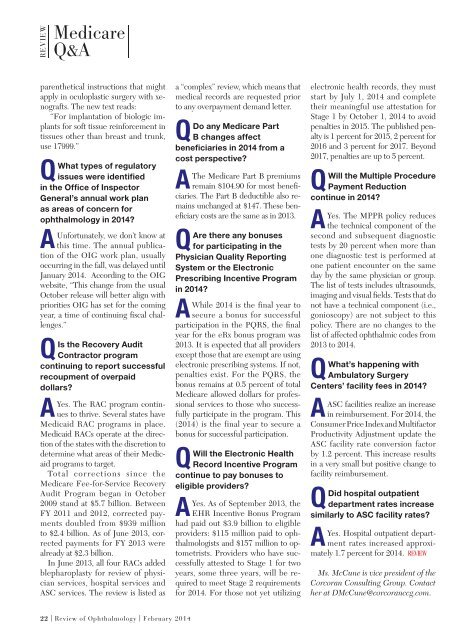dhjBa
dhjBa
dhjBa
Create successful ePaper yourself
Turn your PDF publications into a flip-book with our unique Google optimized e-Paper software.
REVIEW<br />
Medicare<br />
Q&A<br />
parenthetical instructions that might<br />
apply in oculoplastic surgery with xenografts.<br />
The new text reads:<br />
“For implantation of biologic implants<br />
for soft tissue reinforcement in<br />
tissues other than breast and trunk,<br />
use 17999.”<br />
QWhat types of regulatory<br />
issues were identified<br />
in the Office of Inspector<br />
General’s annual work plan<br />
as areas of concern for<br />
ophthalmology in 2014?<br />
AUnfortunately, we don’t know at<br />
this time. The annual publication<br />
of the OIG work plan, usually<br />
occurring in the fall, was delayed until<br />
January 2014. According to the OIG<br />
website, “This change from the usual<br />
October release will better align with<br />
priorities OIG has set for the coming<br />
year, a time of continuing fiscal challenges.”<br />
QIs the Recovery Audit<br />
Contractor program<br />
continuing to report successful<br />
recoupment of overpaid<br />
dollars?<br />
AYes. The RAC program continues<br />
to thrive. Several states have<br />
Medicaid RAC programs in place.<br />
Medicaid RACs operate at the direction<br />
of the states with the discretion to<br />
determine what areas of their Medicaid<br />
programs to target.<br />
Total corrections since the<br />
Medicare Fee-for-Service Recovery<br />
Audit Program began in October<br />
2009 stand at $5.7 billion. Between<br />
FY 2011 and 2012, corrected payments<br />
doubled from $939 million<br />
to $2.4 billion. As of June 2013, corrected<br />
payments for FY 2013 were<br />
already at $2.3 billion.<br />
In June 2013, all four RACs added<br />
blepharoplasty for review of physician<br />
services, hospital services and<br />
ASC services. The review is listed as<br />
a “complex” review, which means that<br />
medical records are requested prior<br />
to any overpayment demand letter.<br />
QDo any Medicare Part<br />
B changes affect<br />
beneficiaries in 2014 from a<br />
cost perspective?<br />
AThe Medicare Part B premiums<br />
remain $104.90 for most beneficiaries.<br />
The Part B deductible also remains<br />
unchanged at $147. These beneficiary<br />
costs are the same as in 2013.<br />
QAre there any bonuses<br />
for participating in the<br />
Physician Quality Reporting<br />
System or the Electronic<br />
Prescribing Incentive Program<br />
in 2014?<br />
AWhile 2014 is the final year to<br />
secure a bonus for successful<br />
participation in the PQRS, the fi nal<br />
year for the eRx bonus program was<br />
2013. It is expected that all providers<br />
except those that are exempt are using<br />
electronic prescribing systems. If not,<br />
penalties exist. For the PQRS, the<br />
bonus remains at 0.5 percent of total<br />
Medicare allowed dollars for professional<br />
services to those who successfully<br />
participate in the program. This<br />
(2014) is the final year to secure a<br />
bonus for successful participation.<br />
QWill the Electronic Health<br />
Record Incentive Program<br />
continue to pay bonuses to<br />
eligible providers?<br />
Yes. As of September 2013, the<br />
A EHR Incentive Bonus Program<br />
had paid out $3.9 billion to eligible<br />
providers: $115 million paid to ophthalmologists<br />
and $157 million to optometrists.<br />
Providers who have successfully<br />
attested to Stage 1 for two<br />
years, some three years, will be required<br />
to meet Stage 2 requirements<br />
for 2014. For those not yet utilizing<br />
electronic health records, they must<br />
start by July 1, 2014 and complete<br />
their meaningful use attestation for<br />
Stage 1 by October 1, 2014 to avoid<br />
penalties in 2015. The published penalty<br />
is 1 percent for 2015, 2 percent for<br />
2016 and 3 percent for 2017. Beyond<br />
2017, penalties are up to 5 percent.<br />
Will the Multiple Procedure<br />
Q Payment Reduction<br />
continue in 2014?<br />
AYes. The MPPR policy reduces<br />
the technical component of the<br />
second and subsequent diagnostic<br />
tests by 20 percent when more than<br />
one diagnostic test is performed at<br />
one patient encounter on the same<br />
day by the same physician or group.<br />
The list of tests includes ultrasounds,<br />
imaging and visual fields. Tests that do<br />
not have a technical component (i.e.,<br />
gonioscopy) are not subject to this<br />
policy. There are no changes to the<br />
list of affected ophthalmic codes from<br />
2013 to 2014.<br />
QWhat’s happening with<br />
Ambulatory Surgery<br />
Centers’ facility fees in 2014?<br />
AASC facilities realize an increase<br />
in reimbursement. For 2014, the<br />
Consumer Price Index and Multifactor<br />
Productivity Adjustment update the<br />
ASC facility rate conversion factor<br />
by 1.2 percent. This increase results<br />
in a very small but positive change to<br />
facility reimbursement.<br />
QDid hospital outpatient<br />
department rates increase<br />
similarly to ASC facility rates?<br />
AYes. Hospital outpatient department<br />
rates increased approximately<br />
1.7 percent for 2014.<br />
Ms. McCune is vice pres ident of the<br />
Corcoran Consulting Group. Contact<br />
her at DMcCune@corcoranccg.com.<br />
22 | Review of Ophthalmology | February 2014


